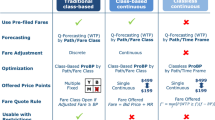Abstract
Demand Driven Dispatch (D3) is the reassignment of aircraft to flights close to departure to improve operating profitability, primarily by utilizing improved knowledge of expected demand from the airline’s revenue management (RM) system. Previous studies of D3 have not incorporated competition and have typically ignored or significantly simplified RM. In this study, the implementation of D3 is tested with complete representations of RM systems in a network environment with competition. Results are from the Passenger Origin Destination Simulator, where stochastic demand by market chooses between competing airlines with alternative schedules and fare products. Findings include important competitive feedback effects from D3 and insights about relationships between D3 and both RM and pricing. Our findings indicate that the benefits of D3 can be estimated at operating profit gains of 0.04–2.03 per cent, revenue gains of 0.02–0.88 per cent, and changes in operating costs of −0.08 to 0.13 per cent. However, use of D3 may harm competitor airlines more than it aids the implementer. D3 swaps early in the booking process can lead to heavy dilution. Late swaps lead to smaller increases in loads but substantial increases in revenue. The relationship between revenue-maximization and cost-minimization in profit-maximizing D3 is highly influenced by the timing of swaps and revenue estimation.





















Similar content being viewed by others
References
AviationWeek Intelligence Network (2014) Aircraft operating statistics and costs. Aviation Daily, June 26, pp. 6–7.
Barnhart, C. (2009) Airline schedule optimization. In: P. Belobaba, A. Odoni and C. Barnhart (eds.) The Global Airline Industry. Chichester, West Sussex, UK: John Wiley & Sons, Ltd., pp. 183–212.
Belobaba, P.P. (1989) OR practice – Application of a probabilistic decision model to airline seat inventory control. Operations Research 37(2): 183–197.
Belobaba, P. (2010) Passenger Origin Destination Simulator (PODS): Summary of Processes and Models. Unpublished Report, Massachusetts Institute of Technology, Cambridge, MA (September).
Berge, M.E. and Hopperstad, C.A. (1993) Demand driven dispatch: A method for dynamic aircraft capacity assignment, models and algorithms. Operations Research 41(1): 153–168.
Bish, E.K., Suwandechochai, R. and Bish, D.R. (2004) Strategies for managing the flexible capacity in the airline industry. Naval Research Logistics 51(5): 654–685.
Cots, R.B. (1999) Revenue Management under Demand Driven Dispatch. Masters Thesis, Massachusetts Institute of Technology, Cambridge, MA.
Etschmaier, M.M. and Mathaisel, D.F. (1984) Aircraft scheduling: The state of the art. Proceedings 24th AGIFORS Annual Symposium. Strasbourg, France, pp. 181–225.
Feldman, J.M. (2002) Matching planes to people. Air Transport World 39(12): 31.
Hoffman, R. (2011) Dynamic airline fleet assignment and integrated modeling. OR News 41: 10–12.
Hung, L.A. (1998) Investigation of Competitive Impacts of Origin-Destination Control using PODS. Masters Thesis, Massachuesetts Institute of Technology, Cambridge, MA.
Jiang, H. (2006) Dynamic Airline Scheduling and Robust Airline Schedule De-Peaking. Ph.D. Thesis, Massachusetts Institute of Technology, Cambridge, MA.
Jiang, H. and Barnhart, C. (2009) Dynamic airline scheduling. Transportation Science 43(3): 336–354.
Peterson, R.M. (1986) The Penultimate Hub Airplane. Seattle, Washigton DC: Internal Memo, Boeing Commercial Airplane Group.
Pilla, V.L., Rosenberger, J.M., Chen, V., Engsuwan, N. and Siddappa, S. (2012) A multivariate adaptive regression splines cutting plane approach for solving a two-stage stochastic programming fleet assignment model. European Journal of Operational Research 216(1): 162–171.
Shebalov, S. (2009) Practical overview of demand-driven dispatch. Journal of Revenue and Pricing Management 8(2/3): 166–173.
Sherali, H.D., Bish, E.K. and Zhu, X. (2005) Polyhedral analysis and algorithms for a demand-driven refleeting model for aircraft assignment. Transportation Science 39(3): 349–366.
Waldman, G.L. (1993) A Study of the Practicality and Profit Enhancement Potential of Demand Driven Dispatch in Airline Hub Operations. Masters Thesis, Massachusetts Institute of Technology, Cambridge, MA.
Wang, X. and Meng, Q. (2008) Continuous-time dynamic network yield management with demand driven dispatch in the airline industry. Transportation Research Part E 44(6): 1052–1073.
Wang, X. and Regan, A. (2006) Dynamic yield management when aircraft assignments are subject to swap. Transportation Research Part B 40(7): 563–576.
Warburg, V., Hansen, T.G., Larsen, A., Norman, H. and Andersson, E. (2008) Dynamic airline scheduling: An anlysis of the potentials of refleeting and retiming. Journal of Air Transport Management 14(4): 163–167.
Weatherford, L.R. and Polt, S. (2002) Better unconstraining of airline demand data in revenue management systems for improved forecast accuracy and greater revenues. Journal of Revenue and Pricing Management 1(3): 234–254.
Williamson, E.L. (1992) Airline Network Seat Inventory Control: Methodologies and Revenue Impacts. Ph.D. Thesis, Massachusetts Institute of Technology, Cambridge, MA.
Author information
Authors and Affiliations
Rights and permissions
About this article
Cite this article
Fry, D., Belobaba, P. Demand driven dispatch and revenue management in a competitive network environment. J Revenue Pricing Manag 15, 380–398 (2016). https://doi.org/10.1057/rpm.2016.29
Published:
Issue Date:
DOI: https://doi.org/10.1057/rpm.2016.29




